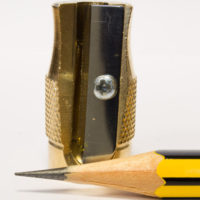My favourite iron gall ink is the one made by Bach’s Tinten. Unfortunately, it is quite difficult to get hold of it …and I fear by now it is not being made any more.
I have two ink bottles from them. One was bought in 2009 as a set with a quill and instructions. The other ink bottle was bought just by itself, i.e. without a quill and instructions.
You might have seen the ink bottle with the crimson ink before as it made an appearance in previous blog posts here at Bleistift.
When cleaning up this weekend, I came across the instruction sheet that came with the ink set. It’s rather nice, so I thought I share a translation with you here:
Fine Historical Stationery
Writing like in old times
At a time when new writing instruments are being introduced to the market by the industry almost every day, the desire for the original arises more and more often in many people. This desire is to be fulfilled by the historical stationery, individually handcrafted as in the old days, taking us back to a time when writing was a very personal way of expression.
The inks
The inks are made according to old recipes, some of which were thought to have been forgotten. Among others, the following natural colour materials are used:
Black inks are made from an acidic tannin-iron compound.
Coloured inks contain, for example, green walnut shells (brown), redwood and chochal lice (red), indigo (blue), turmeric with indigo (green), and various other ingredients, especially gum arabic as a binder.
The iron gall ink is a valuable document ink; its blue ink strokes turn black on the paper and cannot be decomposed – neither by acids, alkalis nor by constant sunlight.
The historic inks are bottled in jars faithfully reproduced from a 19th century model. As in those days, the ink jars are corked and sealed. To open the jar, you clasp it tightly with your hand and press your thumb against the cork. The sealing wax then pops open. The jars should not be left open for any length of time.
The quills
Since time immemorial, people have written with the goose quill, which was replaced at the beginning of the 19th century by the steel pen.
At the beginning of the 19th century, it was replaced by the steel nib and later by the fountain pen. Raven, eagle and swan feathers were also used for writing. The bird feather must not be left in the ink glass, because otherwise it will soften, since it is made of horn. It can be re-cut with a very fine knife. Keel and steel nibs are best for writing on smooth, well-glued paper. Letter, bank mail, and butt papers are preferred, or for special work, genuine skin parchments.
